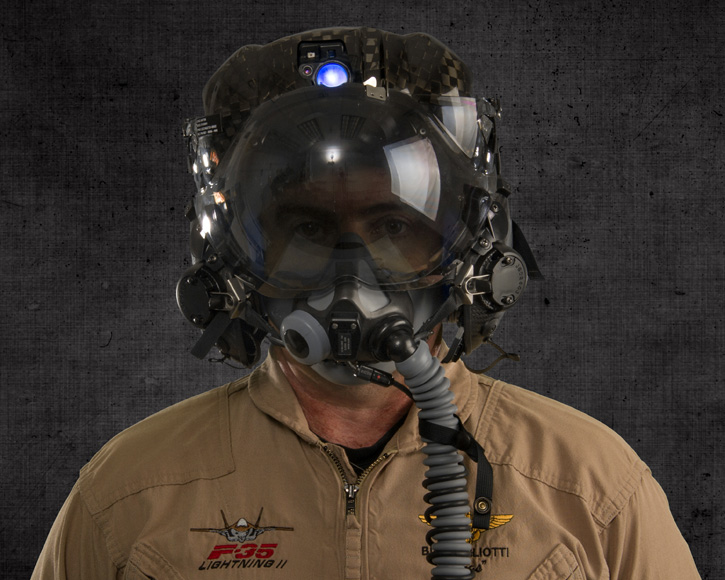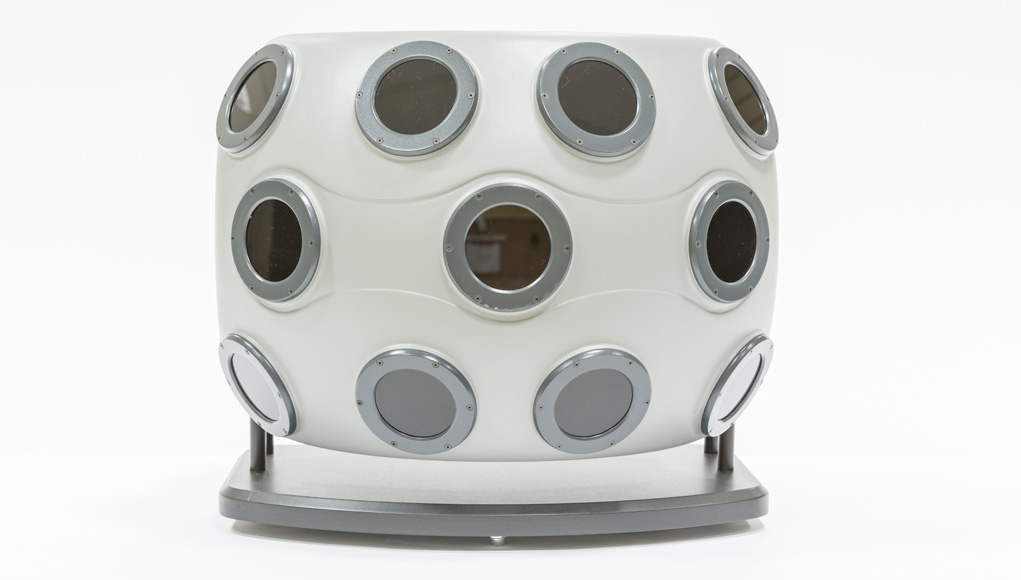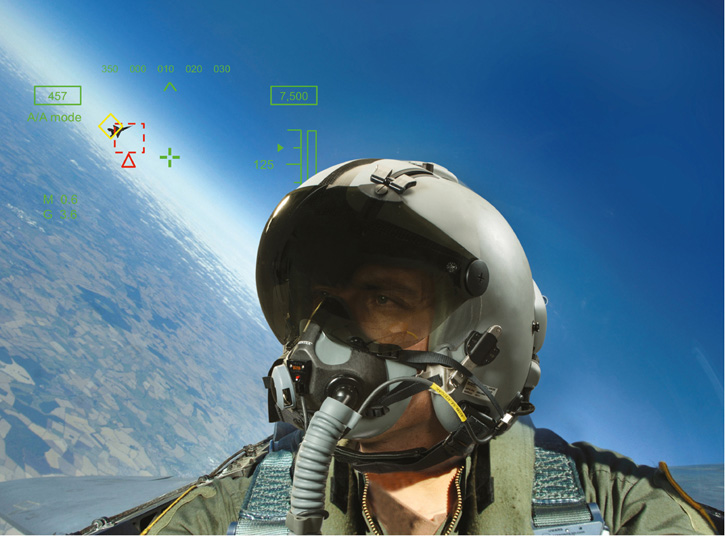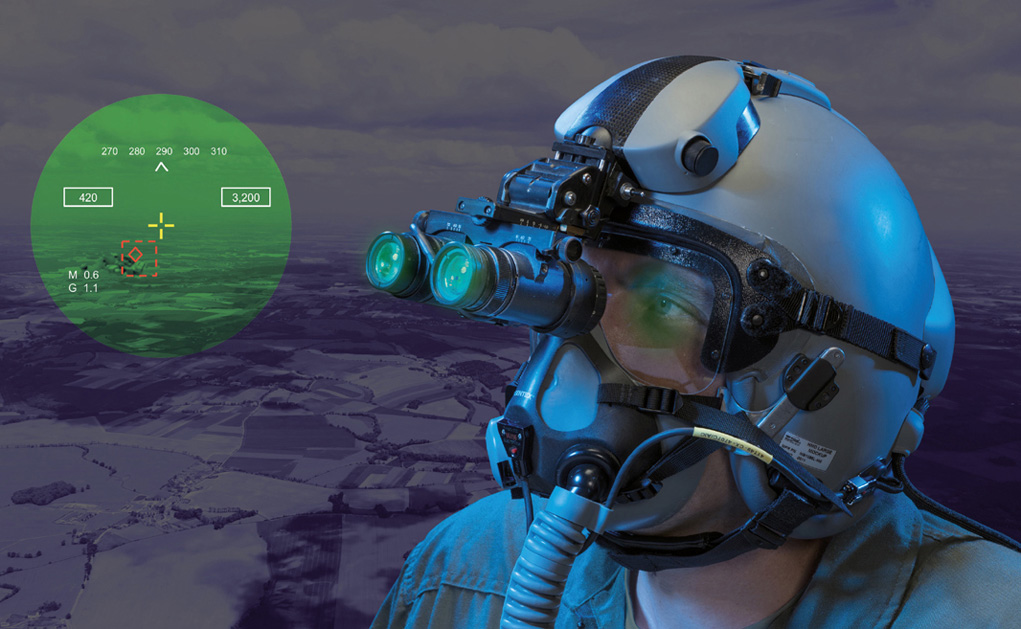
The F-35’s Helmet Mounted Display Systems provide pilots with unprecedented situational awareness. All the information pilots need to complete their missions – airspeed, heading, altitude, targeting information and warnings – is projected on the helmet’s visor, rather than on a traditional Heads-up Display. This approach greatly reduces the pilot’s workload and increases responsiveness.
Additionally, the F-35’s Distributed Aperture System (DAS) streams real-time imagery from six infra-red cameras mounted around the aircraft to the helmet, allowing pilots to “look through” the airframe. The helmet also provides pilots with night vision through the use of an integrated camera. Elbit Systems is jointly developing the system with Rockwell Collins through their Joint Venture company, VSI.
At the Paris Air Show 2015, Elbit Systems is launching ‘SuperVision’ – an innovative man-machine interface that could narrow the gap that the F-35 helmet and displays has opened over current generation aircraft.
The new approach integrates graphical, intuitive presentation of sensor feeds and spatial information using synthetic terrain models, live sensor feeds, tactical information, aircraft and air-data. SuperVision also enables the pilot to interact with the information displayed to him, using standard HOTAS controls and line-of-sight tracking performed by the helmet mounted display and sight system.
The SuperVision interface generates a conformal image of the world outside the cockpit, integrated with data from the aircraft systems, surroundings and threats, fusing together the various layers of information. Harsh environment and weather conditions, in conjunction with the immense flow of information during the flight, call for an intuitive display of flight and visual data.
This new concept integrates sensors, avionics systems and display in an intuitive way, reducing pilots’ workloads and allowing them to focus on the successful completion of their mission, while flying “Head-Up” in any terrain and in all visibility conditions.
SuperVision will be implemented in different ways on fighter aircraft, trainers, transport planes and rotorcraft. Each application will employ different sensors, displays and applications.
 Elbit Systems is also developing BrightNite as a primary flight sensor for helicopters, augmenting the standard Aviator Night Vision Imaging System (ANVIS) and Forward Looking Infra-Red (FLIR) used on current platforms. BriteNite enables utility helicopters to successfully perform Degraded Visual Environment (DVE) missions, including Brownout and Whiteout, in more than 90% of the nights, provides them with piloting capabilities of attack helicopters and enables a new level of operational flight.
Elbit Systems is also developing BrightNite as a primary flight sensor for helicopters, augmenting the standard Aviator Night Vision Imaging System (ANVIS) and Forward Looking Infra-Red (FLIR) used on current platforms. BriteNite enables utility helicopters to successfully perform Degraded Visual Environment (DVE) missions, including Brownout and Whiteout, in more than 90% of the nights, provides them with piloting capabilities of attack helicopters and enables a new level of operational flight.
 For fighter aircraft and trainers, the new Digital Joint Head Mounted Cueing System (D-JHMCS) or Elbit Systems’ Targo helmet display will provide the main SuperVision display and cueing system. The helmets will be used with lightweight and comfortable head mounted display (HMD), which offers an improved HMD Center of Gravity (CG) and balance and thus reduces neck strains. Plug and play, with minimal installation requirements and the ability to operate with the aircraft’s current tracker and Electronic Unit, DJHMCS can replace legacy JHMCS equipment with no A/C modifications required, thus reducing life-cycle costs.
For fighter aircraft and trainers, the new Digital Joint Head Mounted Cueing System (D-JHMCS) or Elbit Systems’ Targo helmet display will provide the main SuperVision display and cueing system. The helmets will be used with lightweight and comfortable head mounted display (HMD), which offers an improved HMD Center of Gravity (CG) and balance and thus reduces neck strains. Plug and play, with minimal installation requirements and the ability to operate with the aircraft’s current tracker and Electronic Unit, DJHMCS can replace legacy JHMCS equipment with no A/C modifications required, thus reducing life-cycle costs.
Among the main advantages of DJHMCS is its ability to display full motion video in color in both day and night missions. The system’s proven symbology, combined with color, creates a superior solution that provides intelligent vision in the cockpit, which is an essential capability for SuperVision integration. For example, color cueing provides immediate and intuitive recognition of friendly, threat and unknown targets, or designates threat areas to create a complete view of the air, ground and sea picture.

The other element supporting SuperVision is the new-generation cockpit (CockpitNG), based on a smart central large area display (LAD) that supports multi- touch technology, to present all avionic components, sensor data and images, tactical displays and maps in one suite. CockpitNG is fully integrated with the Helmet-Mounted and Head-Up displays, allowing pilots to operate the aircraft in a smooth and customizable manner.
SuperVision applications for transport planes, such as the C-130J, or the upgraded C-130, enhance the situational awareness and mission effectiveness of tactical transports flying low-level night missions. A flexible and modular solution, C-Suite provides accurate, real-time information projected on the Head-Up, Head-Down or Helmet Mounted displays.
SuperVision in trainers will enable cadets and pilots to fly on low-cost advanced trainers that will be able to simulate the behavior of advanced aircraft in avionics performance, flight controls and emergency procedures.
Using embedded avionics and advanced helmet displays enabled by the Targo helmet, Elbit Systems is already demonstrating the technology enabling pilots to see virtual targets launching virtual missiles at them, while they fly Aermacchi M-346 Lavi advanced trainers. The cockpit displays on the Lavi will be able to mimic those on the F-16I, F-15I and, eventually, the F-35.
Elbit is a partner in the organization integrating the training suite on the Israeli M-346 and the provider of most of the IAF simulator facilities.






















